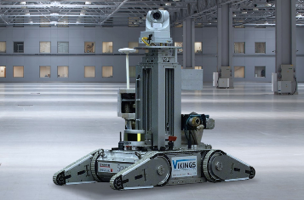The ARGOS Challenge is an international robotics competition “designed to foster the development of a new generation of autonomous robots adapted to oil and gas sites,” which are commonly located in the most extreme conditions in the world. Organizers see this new generation of robots as being autonomous enough to handle inspection tasks, anomaly detection, and even intervening in emergency situations.
The winner of the first round of challenges is a team from ISEEM, or ESIGELEC’s research institute in Rouen, France. For this round, the robot had to perform an automatic inspection in “real conditions,” which required it to pass through control points, read pressure-sensor gauges, and determine whether floodgates were open or closed. The robot also needed to overcome obstacles, including a 20cm wall. ISEEM’s robot beat out teams from Japan, Austria, Spain, and Switzerland by completing the round in under four minutes.
Those of you who follow autonomous vehicles might not be surprised to learn that this Viking Robot uses Velodyne’s VLP-16 “puck” LiDAR sensor as its 3D sensor. To ask a few questions about robots, 3D sensors, and the part that LiDAR will play in the job site of the future, I caught up with Velodyne’s Director of North America sales and Product Management, Wolfgang Juchmann.
Sean Higgins: An oil & gas site seems like an extreme challenge for an autonomous robot. What sort of problems does one of these robots have to overcome in order to be effective in that kind of environment?
Wolfgang Juchmann: Robots in those environments need to work independently and reliably, since they don’t have the luxury of being able to make a quick service call. Often, their very reason for being is to spare people exposure to extreme conditions – say, a nuclear reactor accident or a burst pipe on an oil platform. Robots need to be able to react to events as they occur, which is why real-time 3D perception is important. Catastrophic conditions by definition are unpredictable, so the robot needs to be able to perceive the situation and, based on its algorithms, make the correct choices for the conditions at hand. There simply isn’t time to make a map first, process it and then arrive at conclusions; decisions must be made in real time to avoid further damage.
SH: Besides safety, are there other advantages to using a robot in a situation like this?
WJ: The robot’s advantage is that it follows precise algorithms and isn’t subject to emotional or physical distress. Lacking those human attributes, robots can’t be distracted or scared and stressed by the situation or environment.
SH: Do you think autonomous robots will drastically change the work performed on oil & gas sites?
WJ: Certainly, where mundane and routine tasks are involved – and/or in environments that people find unpleasant, dangerous or threatening – robots can do the job. In disaster scenarios, robots frequently take over to protect human lives.
SH: What are the demands put on a LiDAR sensor in an extreme situation like the emergencies you’re talking about?
WJ: Sensors must be rated for their environment, as Velodyne’s are; our multi-beam LiDAR sensors carry an IP67 rating. In addition, each of our LiDAR sensors undergoes rigorous environmental testing, and not only in the R&D test phase. Every sensor we ship is challenged during vibration testing (up to 3G) and heat and cold cycle testing (between –10C and +60C, over an eight-hour period).
SH: It sounds like these oil & gas applications are highly specialized. Still, we’re still using the same sensors for most verticals. Do you think LiDAR manufacturing has matured to a point where a company like Velodyne will provide sensors for individual applications?
WJ: Yes, absolutely. Up to now, our products have been generic enough to be deployed across a variety of horizontal markets, among them autonomous vehicles, mobile mapping, robotics, UAVs (drones), security, virtual reality, AGVs, etc. Moving forward, we’re developing specialized products for specific vertical markets. Sensors optimized for automotive tasks, as well as lightweight sensors for UAVs and AGVs, are already in our pipeline of next-generation products.






